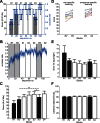Locomotor sequence learning in visually guided walking
- PMID: 26864768
- PMCID: PMC4869504
- DOI: 10.1152/jn.00938.2015
Locomotor sequence learning in visually guided walking
Abstract
Voluntary limb modifications must be integrated with basic walking patterns during visually guided walking. In this study we tested whether voluntary gait modifications can become more automatic with practice. We challenged walking control by presenting visual stepping targets that instructed subjects to modify step length from one trial to the next. Our sequence learning paradigm is derived from the serial reaction-time (SRT) task that has been used in upper limb studies. Both random and ordered sequences of step lengths were used to measure sequence-specific and sequence-nonspecific learning during walking. In addition, we determined how age (i.e., healthy young adults vs. children) and biomechanical factors (i.e., walking speed) affected the rate and magnitude of locomotor sequence learning. The results showed that healthy young adults (age 24 ± 5 yr,n= 20) could learn a specific sequence of step lengths over 300 training steps. Younger children (age 6-10 yr,n= 8) had lower baseline performance, but their magnitude and rate of sequence learning were the same compared with those of older children (11-16 yr,n= 10) and healthy adults. In addition, learning capacity may be more limited at faster walking speeds. To our knowledge, this is the first study to demonstrate that spatial sequence learning can be integrated with a highly automatic task such as walking. These findings suggest that adults and children use implicit knowledge about the sequence to plan and execute leg movement during visually guided walking.
Keywords: human; learning; locomotion; vision; walking.
Copyright © 2016 the American Physiological Society.
Figures




References
-
- Andujar JE, Lajoie K, Drew T. A contribution of area 5 of the posterior parietal cortex to the planning of visually guided locomotion: limb-specific and limb-independent effects. J Neurophysiol 103: 986–1006, 2010. - PubMed
-
- Cohen A, Ivry RI, Keele SW. Attention and structure in sequence learning. J Exp Psychol Learn Mem Cogn 16: 17–30, 1990.
-
- Curran T, Keele SW. Attentional and nonattentional forms of sequence learning. J Exp Psychol Learn Mem Cogn 19: 189–202, 1993.
-
- Dietz V, Zijlstra W, Duysens J. Human neuronal interlimb coordination during split-belt locomotion. Exp Brain Res 101: 513–520, 1994. - PubMed
Publication types
MeSH terms
LinkOut - more resources
Full Text Sources
Other Literature Sources

